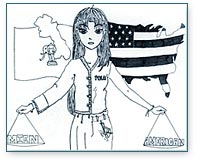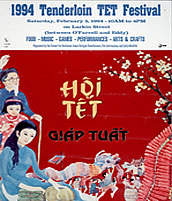 As travel opportunities opened up in the 1990s, individuals began to visit their homelands, bringing back cultural artifacts and a renewed interest in preserving cultural practices. For example, the Iu-Mien, who fear their ethnic practices have been eroded by political instability in their homeland or are disappearing because of lack of interest from their Americanized children, are searching to renew their ethnic culture. Some Iu-Mien visited with the Mien Yao of China, where the Iu-Mien originated, and arranged for leaders to visit the U.S., revitalizing cultural practices and transnational connections. Ethnic groups often make videotapes of pilgrimage trips to their homelands, and companies produce professional videotapes with images of the homeland for sale to returning tourists. As travel opportunities opened up in the 1990s, individuals began to visit their homelands, bringing back cultural artifacts and a renewed interest in preserving cultural practices. For example, the Iu-Mien, who fear their ethnic practices have been eroded by political instability in their homeland or are disappearing because of lack of interest from their Americanized children, are searching to renew their ethnic culture. Some Iu-Mien visited with the Mien Yao of China, where the Iu-Mien originated, and arranged for leaders to visit the U.S., revitalizing cultural practices and transnational connections. Ethnic groups often make videotapes of pilgrimage trips to their homelands, and companies produce professional videotapes with images of the homeland for sale to returning tourists.
As a result of these trips, some members of the younger generation have been able to learn about their history, preserve their heritage language, and trace their ancestral roots. Ironically, homeland cultural practices are themselves not static, since nations and societies continually develop. This means that refugees and immigrants in the U.S. are usually preserving ethnic cultures represented at the time they left, which may no longer be a reflection of the evolving contemporary culture in their homelands. 

|


 As travel opportunities opened up in the 1990s, individuals began to visit their homelands, bringing back cultural artifacts and a renewed interest in preserving cultural practices. For example, the Iu-Mien, who fear their ethnic practices have been eroded by political instability in their homeland or are disappearing because of lack of interest from their Americanized children, are searching to renew their ethnic culture. Some Iu-Mien visited with the Mien Yao of China, where the Iu-Mien originated, and arranged for leaders to visit the U.S., revitalizing cultural practices and transnational connections. Ethnic groups often make videotapes of pilgrimage trips to their homelands, and companies produce professional videotapes with images of the homeland for sale to returning tourists.
As travel opportunities opened up in the 1990s, individuals began to visit their homelands, bringing back cultural artifacts and a renewed interest in preserving cultural practices. For example, the Iu-Mien, who fear their ethnic practices have been eroded by political instability in their homeland or are disappearing because of lack of interest from their Americanized children, are searching to renew their ethnic culture. Some Iu-Mien visited with the Mien Yao of China, where the Iu-Mien originated, and arranged for leaders to visit the U.S., revitalizing cultural practices and transnational connections. Ethnic groups often make videotapes of pilgrimage trips to their homelands, and companies produce professional videotapes with images of the homeland for sale to returning tourists.